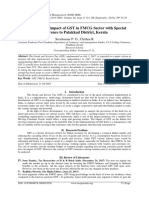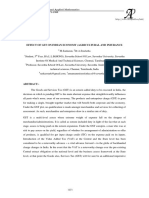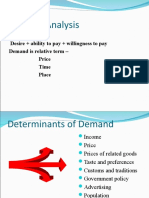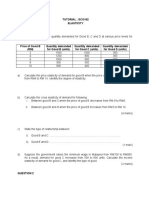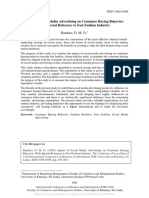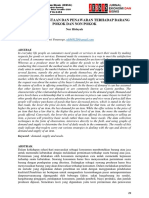Share DOC-20221106-WA0027.
Share DOC-20221106-WA0027.
Uploaded by
sandhiya damodharanCopyright:
Available Formats
Share DOC-20221106-WA0027.
Share DOC-20221106-WA0027.
Uploaded by
sandhiya damodharanCopyright
Available Formats
Share this document
Did you find this document useful?
Is this content inappropriate?
Copyright:
Available Formats
Share DOC-20221106-WA0027.
Share DOC-20221106-WA0027.
Uploaded by
sandhiya damodharanCopyright:
Available Formats
Primax International Journal of Commerce and Management Research Print ISSN: 2321 – 3604
IMPACT OF GST ON CONSUMER SPENDING ABILITY IN CHENNAI CITY
Gowtham Ramkumar1
Abstract
GST is considered to be the important tax reform in the country. Understanding the consumer behavior is important for
every company satisfying their customers through products and services. Taxation is one of the factors that affect the
consumer behavior. Any change in the taxation system will have a significant impact on consumer behavior especially
his purchase decision. These changes can be either in the form of switching brand preferences, consideration of new
factors, increase or decrease in spending ability. Spending ability is the major factor that determines the quantity and
brand that will be purchased by the consumers. GST has impacted all most all the sectors and prices of many products
of day to day use have either increased or remains as same as it was earlier. This research paper seeks to study cause
and effect relationship between GST and spending ability and finally arrives at a meaningful conclusion and provides
scope for further research in this area.
Keywords: GST, Consumer Behavior, Purchase decision and spending ability.
INTRODUCTION Jaiprakash ( 2014) in his research study mentioned that
Taxation plays a major role in the economy of any the GST at the Central and the State level are expected
country. Tax revenues are the major source of income to give more relief to industry, trade, agriculture and
for governments. In fact major social welfare and consumers through a more comprehensive and wider
development schemes are funded through the revenues coverage of input tax set-off and service tax setoff,
generated by taxes in various forms. Tax policies not subsuming of several taxes in the GST and phasing out
only exerts its importance at domestic level but also of CST. Responses of industry and also of trade have
determines the international competitiveness of the been indeed encouraging. Thus GST offers us the best
country. Goods and services tax is a destination based option to broaden our tax base and we should not miss
tax on consumption of goods and services where tax this opportunities to introduce it when the circumstances
will be levied at all stages from the stage of manufacturing are quite favorable and economy is enjoying steady
till the final consumption with tax paid at each stage is growth with only mild inflation.
allowed to set off with the other. GST is one of the biggest According to Prasad (April 5th, 2015) GST will enable
indirect tax reforms and had a significant impact on the simplified Indirect tax regime as per the proposal given
various sectors and also the common man of this nation. and therefore its implementation will remove
complications and multi-layered taxation mechanism.
REVIEW OF LITERATURE
Saravanan Venkadasalam (2014) has analysed the post Zhong (March 19th, 2015) explains the idea of replacing
effect of the goods and service tax (GST) on the national patch work of taxes with a single nationwide sales levy,
growth on ASEAN States using Least Squares Dummy lowering of commercial barriers, the government study
Variable Model (LSDVM) in his research paper. He stated estimates that broad GST would deliver an immediate
that seven of the ten ASEAN nations are already boost output of 1% to 2% and lasting gains in productivity.
implementing the GST. He also suggested that the Chaurasia et al. (2016) Studied, “Role of Goods and
household final consumption expenditure and general Services Tax in the growth of Indian economy” and
government consumption expenditure are positively concluded that in overall GST will be helpful for the
significantly related to the gross domestic product as development of Indian economy and this will also help
required and support the economic theories. But the in improving the Gross Domestic Products of the country
effect of the post GST differs in countries. Philippines more than two percent.
and Thailand show significant negative relationship with
their nation’s development. Meanwhile, Singapore shows STATEMENT OF THE PROBLEM
a significant positive relationship. The new tax regime subsumes various types of indirect
taxes that prevailed in the country and seeks to eliminate
cascading effects of taxes and double counting problem
1
. Research scholar, Madrash Christian College, Chennai
Vol.V, Issue No.3 October – December 2017 Page 71
Primax International Journal of Commerce and Management Research Online ISSN: 2321-3612
in calculating the national income. GST rates had revised whether consumers switch their brand preferences
consumer’s product selection and purchase criteria. because of GST. Classification of consumers on the
Consumers have been shifting their brands due to rise basis of their spending abilities will enable the FMCG
in prices of various products. This necessitates to the companies to select the target market that gives them
impact of GST on consumers purchase decisions which higher profits through better satisfaction of their needs.
involves measuring the spending pattern and other related
dimensions of consumer behavior. Government and Consumers
Government of India will also benefit from this study as
RATIONALE OF THE STUDY it will enable them to understand the impact of GST on
Several research studies focused on the impact of GST the disposable income of the consumers. This study
on different sectors in the Indian economy. These studies also reveals information regarding the satisfaction level
are much related to the sector impact and economic of consumer regarding different GST rates charged for
impact of GST. However very few research studies different goods and services. Understanding the
focused on the impact of GST on consumers. These disposable income of the people will enable them to frame
research studies identify consumer opinion on GST and policies and recommend changes in GST related
some studies gave illustrative explanations of how GST aspects if the disposable income falls after GST.
will benefit the consumers. This research study is also Consumers can reconsider certain factors affecting their
unique because it studies the cause and effect purchase decision after going through the factors
relationship between GST and Consumer ability and identified by the study.
finally test the model fit for the factors affecting the
purchase decision of consumers after GST. RESEARCH METHODOLOGY
The data required for this study is collected from both
OBJECTIVES OF THE STUDY primary and secondary sources.
The objectives of the study are as follows
PRIMARY DATA
1. To study the impact of GST on consumer spending
The primary data for the study is collected through the
ability through multiple regression analysis.
structured questionnaire with close ended questions.
2. To study the relationship between factors affecting
purchase decision of the consumers after GST SECONDARY DATA
implementation. The secondary data for the study is collected from various
sources like journals, magazines and websites.
SCOPE OF THE STUDY
SAMPLING DESIGN
The study titled “ Impact of GST on consumer spending
ability in Chennai city” limits its scope to the consumers The sample size consists of 50 respondents from
in Chennai city. Further it limits its scope to the Chennai city. Simple random sampling technique is used
consumers of FMCG products in Chennai city. As such for the study. A simple random sample is a subset of a
the results of this study are highly applicable to the statistical population in which each member of the subset
consumer behavior in FMCG sector and not to any other has an equal probability of being chosen.
sector in the country. STATISTICAL DESIGN
SIGNIFICANCE OF THE STUDY The statistical design used in this study is Multiple
This study seeks to benefit the following Regression Analysis. Multiple regression is an
extension of simple linear regression. It is used to predict
FMCG Companies the value of a variable based on the value of two or more
This study will enable them to understand the various other variables. Multiple regressions also allow one to
factors affecting purchase decisions of consumers after determine the overall fit (variance explained) of the model
GST implementation in India. Further the study will provide and the relative contribution of each of the predictors to
them an idea about the impact of GST on spending ability the total variance explained.
of the consumers. So this will enable them to frame
their marketing activities and frame pricing strategies in LIMITATIONS OF THE STUDY
such a way that the prices of the products are within the The various limitations of the study are as follows
limits of spending abilities of the consumers and at the The study uses the data collected from both primary
same time give normal profit for the firm as it is only and secondary data. Therefore limitations of these
possible in long run in a monopolistic competitive market sources apply to this study.
like Chennai. Further it will enable them to understand
Vol.V, Issue No.3 October – December 2017 Page 72
Primax International Journal of Commerce and Management Research Print ISSN: 2321 – 3604
The study deals with the data made available and therefore it may not judge the entire scenario.
The study limits itself to the consumers of FMCG sector and not the other sector.
DATA ANALYSIS AND INTERPRETATION
TABLE - 1 : SHOWING DESCRIPTIVE STATISTICS REGARDING THE CONSUMERS OPINION ON THE
IMPACT OF GST.
Descriptive Statistics
N Minimum Maximum Mean Std. Deviation
Less money after GST 100 1.00 5.00 3.5700 .94554
Rise in Inflation level 100 1.00 5.00 3.5500 .96792
Fall in price 100 1.00 5.00 3.2400 1.46419
Valid N (listwise) 100
INTERPRETATION
From the above table it is clear that the consumers are less with less money after GST. Based on the mean score
3.57, it is proved that the GST has increased the prices resulting in less money for consumers to spend after GST.
The next mean score is for rise in inflation level which is indicated by the mean value of 3.55. Every recent reports
show that the WPI has increased to around 8% which is signal of rising inflation in the country. The rise in inflation
level reduces the purchasing power of the people which is reflected by the consumer opinion in the form of less
money after GST. However some consumers feel that the GST has resulted in fall in price of goods and services.
Statistically, the mean and standard deviation has direct relationship between them. From the table it is clear that
as the mean decreases the standard deviation increases. Generally a high mean score is preferred and less mean
score least preferences of the consumers for the particular variable given for the study by the researcher.
Notes to Multiple Regression Analysis
Y = GST Rates
X1 = Spending Ability of the consumers
Multiple Regression Analysis
Model Unstandardized Coefficients Standardized Coefficients t Sig.
B Std. Error Beta
(Constant) 10.050 .821 12.241 .000
X1 1.137 .205 .488 5.542 .000
The Regression Equation is as follows
Y = 10.050 + 1.137 X1
INTERPRETATION
From the above table it is clear that GST rates have a significant impact on the spending ability of the consumers
in Chennai city.
H0 - GST rates has no impact on the spending ability of the consumers in Chennai city.
H1 – GST rates has significant impact on the spending ability of the consumers in Chennai city.
From the above table it is clear that both the variables are highly significant at 1% significance level which is
indicated by the p-value of less than 0.01. Therefore, the null hypothesis is rejected and research hypothesis is
accepted. This is true because GST has increased the prices of some goods in the market and for other prices were
remaining same as it was earlier. Increase in prices leads to reduction in quantity of purchase for the same amount
before GST is charged. Thus the spending ability decreases for the consumers. It should also be noted that the
GST rates have positive effect on the spending ability of the consumers in Chennai city. Statistically, for every one
Vol.V, Issue No.3 October – December 2017 Page 73
Primax International Journal of Commerce and Management Research Online ISSN: 2321-3612
increase in Y variable, the X1 increases by 1.137 times. by consumer. The real benefits can be experienced by
Thus the increase in independent variable is more than the consumers only when the utilized tax savings by
the increase in dependent variable. companies in the form of input tax credit is transferred
to the consumers.
FINDINGS
The various findings of the study are as follows REFERENCES
Consumers are left with less money after GST with 1. Gupta, S.P., “Statistical Methods”, Sultan Chand and
highest mean score of 3.57 due to rise in prices. Sons Publishers, 1984.
GST has resulted in increasing the inflation level in 2. Akansha Khurana and Aastha Sharma on “GST- A
the country. positive reform for indirect taxation system”
International journal of advance research, (2016) vol
GST rates and Spending ability have positive cause
4, issue3.pp-500-505.
and effect relationship between them.
3. Dr. R. Vasanthagopal (2011), “GST in India: A Big
GST rates and spending ability are highly significant
Leap in the Indirect Taxation System”, International
at 1% level as the P-Value is less than 0.01.
Journal of Trade, Economics and Finance, Vol. 2,
CONCLUSION No. 2, April 2011.
To Conclude, GST has been successfully implemented 4. Agogo Mawuli (2014): “Goods and Service Tax- An
by the government of India. It has affected all the sectors Appraisal”Paper presented at the the PNG Taxation
in the economy. However the initial fall in the economic Research and Review Symposium, Holiday Inn, Port
growth is now reflecting a growing trend. However as Moresby,29-30.
per latest reports inflation indices are showing an 5. www.gstindia.com/basics-of-gst-implementation-in-
increasing trend. Each and every consumer is affected india
Vol.V, Issue No.3 October – December 2017 Page 74
You might also like
- Impact of GST On Consumer Spending Ability in Chennai City: December 2017Document5 pagesImpact of GST On Consumer Spending Ability in Chennai City: December 2017Shyam SharmaNo ratings yet
- 5857-Article Text-10814-1-10-20210510Document7 pages5857-Article Text-10814-1-10-20210510katejagruti3No ratings yet
- IJRPR19410Document5 pagesIJRPR19410PARAKRAM ROYNo ratings yet
- Impact of GST On FMCG AnkitDocument18 pagesImpact of GST On FMCG AnkitMohit BamraraNo ratings yet
- FMEC PROJECT After GSTDocument45 pagesFMEC PROJECT After GSTdeepankarbiswas456No ratings yet
- 1922 B.com B.com Batchno 43Document81 pages1922 B.com B.com Batchno 43365itrNo ratings yet
- Siya - BCH 17 216 (Project)Document42 pagesSiya - BCH 17 216 (Project)ManthanNo ratings yet
- SOORYADocument33 pagesSOORYAsruthi kjNo ratings yet
- GST PDFDocument6 pagesGST PDFanwesa duttaNo ratings yet
- 1222-Article Text-2387-1-10-20201202Document11 pages1222-Article Text-2387-1-10-20201202krutika sutarNo ratings yet
- Aman Project Report 1Document41 pagesAman Project Report 1Kunal PaswanNo ratings yet
- Fin Irjmets1691217667Document6 pagesFin Irjmets1691217667BIKRAM KUMAR BEHERANo ratings yet
- CC 6.1 (CH) Final Project Report 6th SemDocument35 pagesCC 6.1 (CH) Final Project Report 6th SemTanay Manna Roll 199No ratings yet
- Impact of GST On FMCG Companies in India: Ayesha Safa SayedDocument9 pagesImpact of GST On FMCG Companies in India: Ayesha Safa SayedShyamsunder SharmaNo ratings yet
- GST's Effect On Start-Ups: TOPSIS Approach On Compliances, Cost and Tax FactorsDocument9 pagesGST's Effect On Start-Ups: TOPSIS Approach On Compliances, Cost and Tax FactorsarunNo ratings yet
- A Study of Impact of GST On Hotel IndustryDocument32 pagesA Study of Impact of GST On Hotel Industrynaman67% (3)
- (KMBN-308) : Synopsis PresentationDocument9 pages(KMBN-308) : Synopsis PresentationNeetika TripathiNo ratings yet
- Impact of GST On Msmes: July 2019Document8 pagesImpact of GST On Msmes: July 2019hariom bajpaiNo ratings yet
- A Study On Impact of GST On Indian EconomyDocument12 pagesA Study On Impact of GST On Indian Economyba7443789No ratings yet
- Impact of Goods and Services Tax (GST) On The Buying Behaviour of FMCG Consumers in Alanalloor Grama Panchayath, Palakkad (DT)Document5 pagesImpact of Goods and Services Tax (GST) On The Buying Behaviour of FMCG Consumers in Alanalloor Grama Panchayath, Palakkad (DT)iaetsdiaetsd100% (8)
- Project ProposalDocument17 pagesProject ProposalAmit MirjiNo ratings yet
- Research ProjectDocument23 pagesResearch ProjectBaivaw jainNo ratings yet
- 12 Dr. Mukesh K. Sharma & Suniti Saini PDFDocument10 pages12 Dr. Mukesh K. Sharma & Suniti Saini PDFBabyGiant LucasNo ratings yet
- Malaysian Spending Patterns Prior To Goods and Services Tax (GST) ImplementationDocument6 pagesMalaysian Spending Patterns Prior To Goods and Services Tax (GST) ImplementationABABNo ratings yet
- GST IjrteDocument8 pagesGST Ijrteakhileshyadav3794186No ratings yet
- Ijm 10 04 009Document7 pagesIjm 10 04 009ba7443789No ratings yet
- Exploring GST: Its Effects On The Indian Economy Dr. Dhiraj Raghunath OvhalDocument8 pagesExploring GST: Its Effects On The Indian Economy Dr. Dhiraj Raghunath OvhalSocial VisionNo ratings yet
- Reasearch PaperDocument6 pagesReasearch Paperpathaksameer456No ratings yet
- Impact of GST (Goods and Service Tax) and Economic Growth in IndiaDocument9 pagesImpact of GST (Goods and Service Tax) and Economic Growth in IndiaSoham JainNo ratings yet
- Summer Internship ProjectDocument8 pagesSummer Internship ProjectShubham ChinchaneNo ratings yet
- IJCRT2307572Document5 pagesIJCRT2307572meha jainNo ratings yet
- Impact F GST in Indian EconomyDocument20 pagesImpact F GST in Indian EconomyAKHIL H KRISHNANNo ratings yet
- The Impact of GST in Various Sectors: Issue 1 December 2016 ISSN: 2319-961XDocument9 pagesThe Impact of GST in Various Sectors: Issue 1 December 2016 ISSN: 2319-961Xdebadattakumbha13No ratings yet
- GSTDocument6 pagesGSTSuchi PatelNo ratings yet
- A Study On Impact of GST On FMCG Companies in IndiaDocument4 pagesA Study On Impact of GST On FMCG Companies in IndiaShyamsunder SharmaNo ratings yet
- DqdedDocument13 pagesDqdedANKUR GUPTANo ratings yet
- Consumer Perceptions PDFDocument14 pagesConsumer Perceptions PDFponniNo ratings yet
- A Study On Impact of GST On RetailersDocument9 pagesA Study On Impact of GST On RetailersKrishna Nandhini Viji100% (1)
- 3 - 44 A Opportunities and Challenges and Its Impact of GST On Indian EconomyDocument5 pages3 - 44 A Opportunities and Challenges and Its Impact of GST On Indian EconomykesharimanaviNo ratings yet
- GST An OverviewDocument30 pagesGST An OverviewMadhavi MehtaNo ratings yet
- A Study On Perspective Impact of GST On FMCG Sector in IndiaDocument12 pagesA Study On Perspective Impact of GST On FMCG Sector in Indiakatejagruti3No ratings yet
- Research Work NEWDocument17 pagesResearch Work NEWRitikaNo ratings yet
- A Study On The Impact of Demonetization and GST On The Indian Banking SectorDocument8 pagesA Study On The Impact of Demonetization and GST On The Indian Banking SectorAnonymous izrFWiQNo ratings yet
- GST - Revised PPT 09 Feb 2021-6Document132 pagesGST - Revised PPT 09 Feb 2021-6Ruksar SharifNo ratings yet
- ComputersDocument68 pagesComputersvaishnavibaddi24No ratings yet
- Measuring Awareness About Implementation of GST: A Survey of Small Business Owners of RajasthanDocument10 pagesMeasuring Awareness About Implementation of GST: A Survey of Small Business Owners of Rajasthanchinmay gandhiNo ratings yet
- Navigating Tax Dynamics Through An In-Depth Simulation of Vat Rate Changes On Consumer Spending Patterns in NigeriaDocument19 pagesNavigating Tax Dynamics Through An In-Depth Simulation of Vat Rate Changes On Consumer Spending Patterns in NigeriaIJMSRTNo ratings yet
- GST On Hotel IndustryDocument22 pagesGST On Hotel Industrytdvora08No ratings yet
- Shri Ramswaroop Memorial College of Engineering and ManagementDocument8 pagesShri Ramswaroop Memorial College of Engineering and ManagementNeetika TripathiNo ratings yet
- JFAM V11 N2 P03 Muhammad Fahad InflationDocument8 pagesJFAM V11 N2 P03 Muhammad Fahad InflationMuhammad SulemanNo ratings yet
- GST Final PaperDocument5 pagesGST Final PaperIjcams PublicationNo ratings yet
- Impact of GST On Hotel & Tourism IndustryDocument18 pagesImpact of GST On Hotel & Tourism Industryjogav10621No ratings yet
- Komal Tathod (Finance)Document54 pagesKomal Tathod (Finance)yashpal PatilNo ratings yet
- Impact of GST On Various Construction ProjectDocument80 pagesImpact of GST On Various Construction ProjectUMAR SAYYEDNo ratings yet
- Merits and Demerits of Income Tax VDocument6 pagesMerits and Demerits of Income Tax VSayantika SenguptaNo ratings yet
- PK PDFDocument13 pagesPK PDFkatejagruti3No ratings yet
- Goods and Services Tax - First ReviewDocument12 pagesGoods and Services Tax - First Reviewrkesavan1656No ratings yet
- Review of Literature2Document23 pagesReview of Literature2Sarthak joshiNo ratings yet
- Industry Internship ReportDocument28 pagesIndustry Internship ReportDIP SHROTNo ratings yet
- The Measure of Economies: Measuring Productivity in an Age of Technological ChangeFrom EverandThe Measure of Economies: Measuring Productivity in an Age of Technological ChangeMarshall B. ReinsdorfNo ratings yet
- Consumer Behavior Towards Over-The-Counter Medicine Purchase: The Extended Theory of Planned BehaviourDocument9 pagesConsumer Behavior Towards Over-The-Counter Medicine Purchase: The Extended Theory of Planned Behavioursairaam TechNo ratings yet
- Consumer Buying Behaviour Towards F.M.C.G. ProductsDocument17 pagesConsumer Buying Behaviour Towards F.M.C.G. ProductsMax CharadvaNo ratings yet
- Demand Analysis: Demand Desire + Ability To Pay + Willingness To Pay Demand Is Relative Term - Price Time PlaceDocument44 pagesDemand Analysis: Demand Desire + Ability To Pay + Willingness To Pay Demand Is Relative Term - Price Time PlaceAbhishek GargNo ratings yet
- CAO712S Schiffman CB10e IM 08Document26 pagesCAO712S Schiffman CB10e IM 08Chiedza MatimuraNo ratings yet
- Vigneron, Johnson - Measuring Perceptions of Brand LuxuryDocument24 pagesVigneron, Johnson - Measuring Perceptions of Brand LuxuryMiguel Angelo Hemzo100% (1)
- A Project Report: Submitted byDocument21 pagesA Project Report: Submitted byramNo ratings yet
- PrivateDocument6 pagesPrivateprishaNo ratings yet
- Ec101, Test A Instructions: Answer Questions 1-12 On The Left-Hand Margin Without Skipping LinesDocument2 pagesEc101, Test A Instructions: Answer Questions 1-12 On The Left-Hand Margin Without Skipping LinesLuke MadzikotoNo ratings yet
- MKT243 CHP 2Document16 pagesMKT243 CHP 2popsodaNo ratings yet
- w2 Understanding Customer and Their Buying Behavior Temp Change ReDocument56 pagesw2 Understanding Customer and Their Buying Behavior Temp Change ReYoko DwiputraNo ratings yet
- Buying Green: Consumer BehaviorDocument3 pagesBuying Green: Consumer BehaviorNarender KumarNo ratings yet
- Looking For Help With Case Solution On Nestle India Creating A New CSR Strategy?Document45 pagesLooking For Help With Case Solution On Nestle India Creating A New CSR Strategy?SaadAminNo ratings yet
- A Study On Consumer Behaviour in Real Estate SectorDocument94 pagesA Study On Consumer Behaviour in Real Estate SectorNadeem khan100% (2)
- Customer Satisfaction On Hyundai CarsDocument49 pagesCustomer Satisfaction On Hyundai CarsVikas BhardwajNo ratings yet
- Tutorial: Eco162 ElasticityDocument3 pagesTutorial: Eco162 ElasticityyasmeenNo ratings yet
- CHAPTER 1234 and 5 Practical Research 2Document28 pagesCHAPTER 1234 and 5 Practical Research 2paredesaudreyrose9No ratings yet
- Kotler Pom17e PPT 06Document32 pagesKotler Pom17e PPT 06Thanh ThảoNo ratings yet
- Literature ReviewDocument3 pagesLiterature ReviewAmbrish Sangshetty0% (1)
- Impact of Social Media Advertising On Consumer Buying Behavior: With Special Reference To Fast Fashion IndustryDocument16 pagesImpact of Social Media Advertising On Consumer Buying Behavior: With Special Reference To Fast Fashion IndustryDhaval LathiyaNo ratings yet
- College Students Level of Awareness Towards Cadbury & Nestle Bar Chocolates Dr. R. Manikandan & A. RamkumarDocument4 pagesCollege Students Level of Awareness Towards Cadbury & Nestle Bar Chocolates Dr. R. Manikandan & A. Ramkumarsantosh tamtaNo ratings yet
- Consumer Behavior and DemandDocument30 pagesConsumer Behavior and DemandtravistroyNo ratings yet
- Beauty and The E-Commerce Beast PDFDocument14 pagesBeauty and The E-Commerce Beast PDFFranck MauryNo ratings yet
- Analisis Permintaan Dan Penawaran Terhadap Barang Pokok Dan Non PokokDocument9 pagesAnalisis Permintaan Dan Penawaran Terhadap Barang Pokok Dan Non PokokWahyu Al Fatih100% (1)
- Consumer Demand - Demand Curve, Demand Function & Law of DemandDocument4 pagesConsumer Demand - Demand Curve, Demand Function & Law of DemandVarun KalseNo ratings yet
- Gujarat Technological University: Learning Outcome Component Learning Outcome (Learner Will Be Able To)Document5 pagesGujarat Technological University: Learning Outcome Component Learning Outcome (Learner Will Be Able To)Mavani snehaNo ratings yet
- Sustainable Competitive Advantage of Internet Firms - A Strategic Framework and Implications For Global MarketersDocument15 pagesSustainable Competitive Advantage of Internet Firms - A Strategic Framework and Implications For Global MarketersClaudia GonzalezNo ratings yet
- Halidu ProjectDocument36 pagesHalidu ProjectUmar FarouqNo ratings yet
- A Power Point Presentation On Consumer BehaviourDocument12 pagesA Power Point Presentation On Consumer BehaviourSriram MuraleedharanNo ratings yet
- Airline Industry MarketingDocument8 pagesAirline Industry MarketingSandra OpreaNo ratings yet
- DocumentDocument54 pagesDocumentRaj ShenoyNo ratings yet








